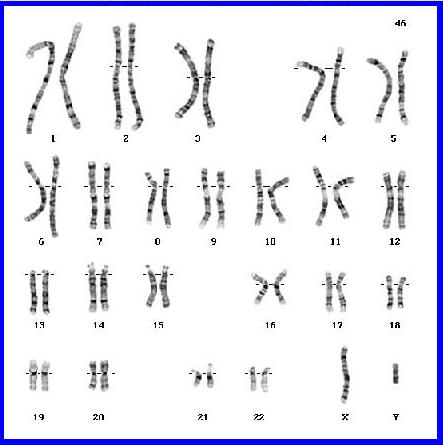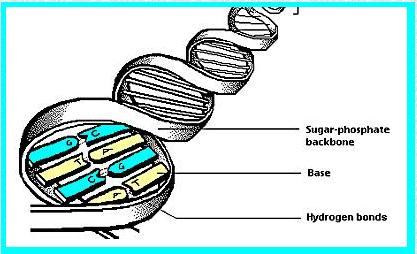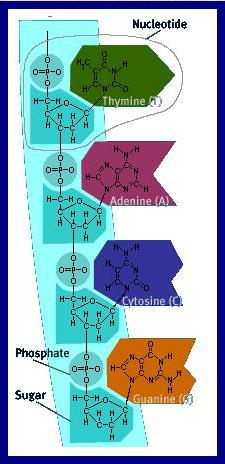 Lesson 5:
Lesson 5:
 Life's History: The Great Adventure
Life's History: The Great Adventure
|
 5.6
5.6
 The Genetic Record
The Genetic Record

|

|
Figure 5.6.1
 Human chromosomes.
Human chromosomes.
|
In the Icelandic creation story, the first humans, man and woman, are made from two trees. In
Greek legend, the nymph Daphne escapes from amorous pursuit by Apollo
by turning into a tree. Are we related to trees?
Of course we are related to trees. Animals and plants belong to the kingdom, "Eukarya",
specialized cells with nuclei that make a living by using similar
chemical machinery and that reproduce sexually according to a certain
protocol. With such a complicated program in common, we must assume a
common ancestor.
But we could not have guessed that from the geologic record, or even just by looking at the
outside appearance of animals and plants. While organisms and fossils
can be grouped by morphology, such groupings are impossible when
contemplating distant relatives with no morphological similarity. How
similar is a fly to a frog? To answer this kind of question, we need
to study the genes, the units of inheritance that make up the
chromosomes in the nuclei of their cells. The more genes they share,
the more similar are two organisms.

|

|
Figure 5.6.2
 The 3-dimensional structure of a DNA
The 3-dimensional structure of a DNA
molecule. The two individual strands of DNA are
joined at their base pairs like steps in a ladder.
|
The genetic information is contained in DNA molecules (deoxyribonucleic acid),
a fact discovered in 1944. DNA is a kind of code for instructions of
making amino acids which are the building blocks of proteins. (Proteins
govern the life processes within cells). The DNA code has only four
letters (unlike the 26-letter
Latin alphabet which we use to write code called English). The four
code elements are called "bases". They are small molecules that attach to a
backbone structure, like steps in a ladder. The bases are adenine, guanine,
cytosine and thymine.

|

|
Figure 5.6.3
 There are only four different "bases" used
There are only four different "bases" used
in the DNA molecule. Their structures are shown above.
Adenine can link only to thymine and cytosine always
pairs with guanine.
|
When the process of making amino acids begins, the two DNA strands separate
from each other, exposing their base pairs. Starting at one end of the strand,
each group of three letters is called a "codon". Each codon makes one amino
acid. For example, in the partial DNA strand shown above, the first codon
is "thymine-adenine-cytosine" or TAC. TAC codes for the amino acid tyrosine.
There are 20 amino acids found in the proteins of living organisms.
The Austrian-American biochemist Erwin Chargaff (b. 1905) broke down the DNA molecules of
cells in the laboratory and separated their constituents using paper
chromatography. (In this process, a fluid containing the fragments is
allowed to creep up a column of absorbent fibrous paper. Different
fragments move at different speeds, and thus are separated from each
other.) He demonstrated that the number of guanine units is precisely
equal to the number of cytosine units and that the same pairing is
true for adenine and thymine.
X-ray studies of DNA (by the English biophysicist Rosalind Franklin, 1920-1958) suggested a
helical structure. The explanation for these two properties (pairings
and helix) came from the DNA-model built by the American biochemist
James D. Watson (b. 1928) and the English physicist Francis Crick (b.
1916). The model shows how DNA is replicated: when separated in the
middle, each strand readily builds a complementary strand to achieve
the original configuration. Errors in the replication process
represent mutations.
The more time is available, the more such errors can accumulate, as the process of
replication is repeated again and again with each generation of an
organism. So, the genetic endowment of a certain type of organism can
drift off in unforeseen directions. In fact, such genetic drift results in new types
of organisms. If such a new type is viable, and lucky, and if the population it lives in is
small, a mutation can spread rapidly through the population. With enough mutations,
one population can then look (or act) differently from its ancestor population. (Only
beneficial or inconsequential mutations will spread within a population. Genes
which make the individual or group less likely to survive will be eliminated by
natural selection.)
So, by determining the types of DNA present in two organisms (or else the RNA produced by
the DNA), we can estimate their genetic distance. This is only done
on portions of the genetic code, because a full determination would
be extremely costly. From this type of study we know, since 1984,
that humans and chimpanzees are more closely related to each other
than chimps are to gorillas or to orangutans. So, when we talk about
"humans and apes", it is like talking about "lions and cats". We would
have to say "lions and other cats" for good logic.
From the genetic approach, the "bush of life" has emerged, thanks to the work of Ralph
S. Wolfe (b. c 1930) and Carl Woese (b. 1928). The "tree of life" once propagated by
the German biologist and paleontologist Ernst Haeckel (1834-1919) (and reproduced or
modified in the textbooks of the 20th century) relates mainly to the classification
of the animal kingdom and to the fossils of the Phanerozoic. It is
not representative of Life as a whole. Also, the "tree of life" commonly tends to imply that
evolution is somehow programmed to produce people. The "bush of life" has no
such implication.
The bush may not have a very orderly root at all. There is evidence for horizontal exchange
of genes between different types of bacteria and even across
kingdoms, between bacteria and archea. If such exchange was the rule
early during evolution, the roots of the various kingdoms are
hopelessly entangled, and we shall never be able to reconstruct
something like a "last common ancestor" for the life forms on Earth.
|





















